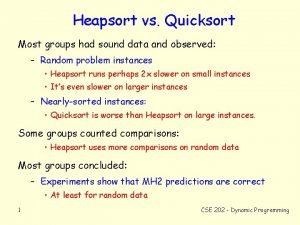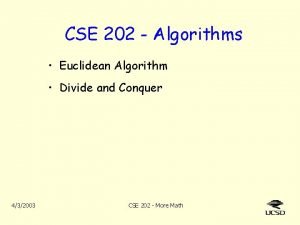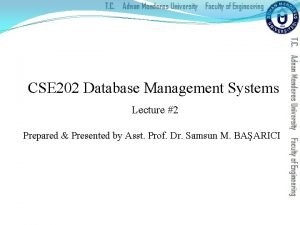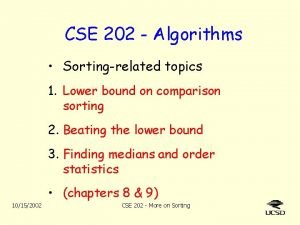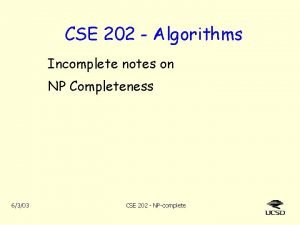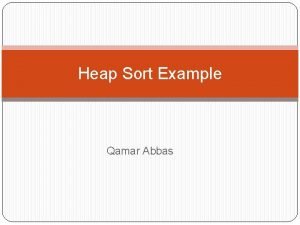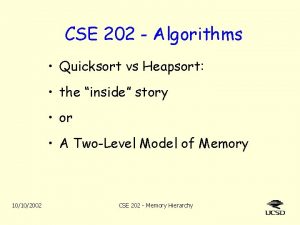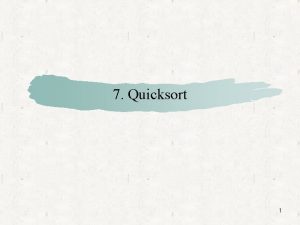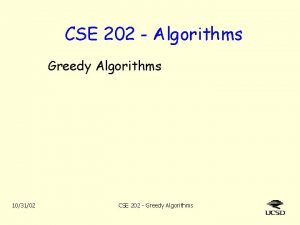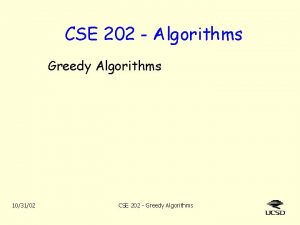CSE 202 Algorithms Quicksort vs Heapsort the inside









- Slides: 9

CSE 202 - Algorithms • Quicksort vs Heapsort: • the “inside” story • or • A Two-Level Model of Memory 10/17/2003 CSE 202 - Memory Hierarchy

Where are we • Traditional (RAM-model) analysis: Heapsort is better – Heapsort worst-case complexity is (n lg n) – Quicksort worst-case complexity is (n 2). • average-case complexity should be ignored. • probabilistic analysis of randomized version is (n lg n) • Yet Quicksort is popular. • Goal: a better model of computation. – It should reflect the real-world costs better. – Yet should be simple enough to perform asymptotic analysis. 2 CSE 202 - Memory Hierarchy

2 -level memory hierarchy model (MH 2) Data moves in “blocks” from Main Memory to cache. A block is b contiguous items. It takes time b to move a block into cache. Cache can hold only b blocks. Least recently used block is evicted. Main Memory Cache CPU Individual items are moved from. Note - “b” affects: Cache to CPU. 1. block size Takes 1 unit of time. 3 2. cache capacity (b 2) 3. transfer time CSE 202 - Memory Hierarchy

2 -level memory hierarchy model (MH 2) For asymptotic analysis, we want b to grow with n b = n 1/3 or n 1/4 are plausible choices block size = b (Bytes) cache size = b 2 (Bytes) transfer (cycles) memory = n (Bytes) Memory = DRAM Cache = SRAM 26 - 2 8 213 - 220 25 -27 226 - 230 b = n 1/4 27 214 27 228 Memory = disk Cache = Dram 212 - 213 b=n 1/3 213 4 226 - 230 215 – 220 233 – 238 226 213 239 CSE 202 - Memory Hierarchy

Cache lines of heap (b=8, n=511, h=9) 1 2 3 4 8 5 9 10 16 17 . . 32. . . 39 64. . 71. 128. . 256 5 . . . 6 11 12 23 24 25 40. . . 47. . . 3 . . . 13 14 15 . . 48. . . 55. . . 6 levels, 8 blocks 7 . . . 31 56. . . 63. . . 127. . . 255 h/3 levels 511 CSE 202 - Memory Hierarchy

A worst-case Heapsort instance Each Extract-Max goes all the way to a leaf. Visits to each node alternate between left and right child. Actually, for any sequence of paths from root to leaves, one can create example. 15 14 13 10 12 9 11 2 6 4 8 7 1 5 3 Construct starting with 1 -node heap 6 CSE 202 - Memory Hierarchy

MH 2 analysis of Heapsort • Assume b = n 1/3. – Similar analysis works for b = na, 0 < a < ½. • Effect of LRU replacement: – First n 2/3 heap elements will “usually” be in cache. • Let h = lg n be height of the tree. • These elements are all in top (2/3)h of tree. – Remaining elements won’t usually be in cache. • In worst case example, they will never be in cache when you need them. • Intuition: Earlier blocks of heap are more likely to be references than a later one. When we kick out an early block to bring in a later one, we increase misses later. 7 CSE 202 - Memory Hierarchy

MH 2 analysis of Heapsort (worst-case) • Every access below level (2/3)h is a miss. • Each of the first n/2 Extract-max’s “bubbles down” to the leaves. – So each has at least (h/3)-1 misses. – Each miss takes time b. • Thus, T(n) > (n/2) ((h/3)-1) b. – Recall: b = n 1/3 and h = lg n. • Thus, T(n) is (n 4/3 lg n). • And obviously, T(n) is O(n 4/3 lg n). – Each of c n lg n accesses takes time at most b = n 1/3. 8 (where c is constant from RAM analysis of Heapsort). CSE 202 - Memory Hierarchy

Quicksort MH 2 complexity • Accesses in Quicksort are sequential – Sometimes increasing, sometimes decreasing • When you bring in a block of b elements, you access every element. – Not 100% true, but I’ll wave my hands • We take b time to get block for b accesses • Thus, time in MH 2 model is same as RAM. – Θ(n lg n) Bottom Line: MH 2 analysis shows Quicksort has lower complexity than Heapsort! 9 CSE 202 - Memory Hierarchy
